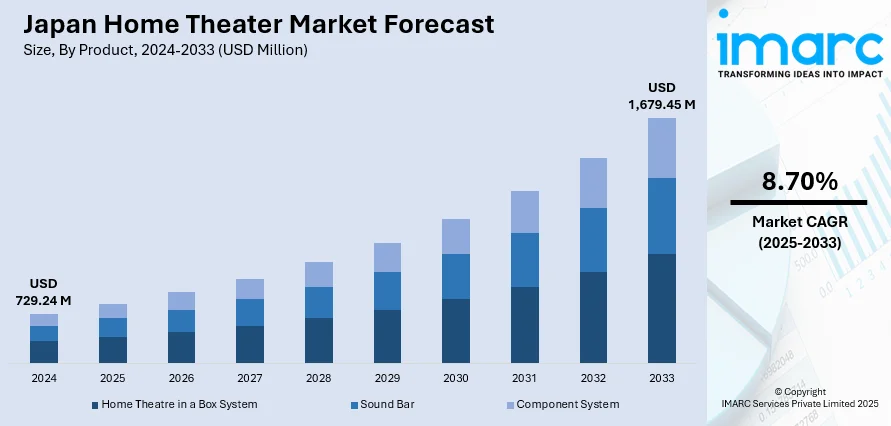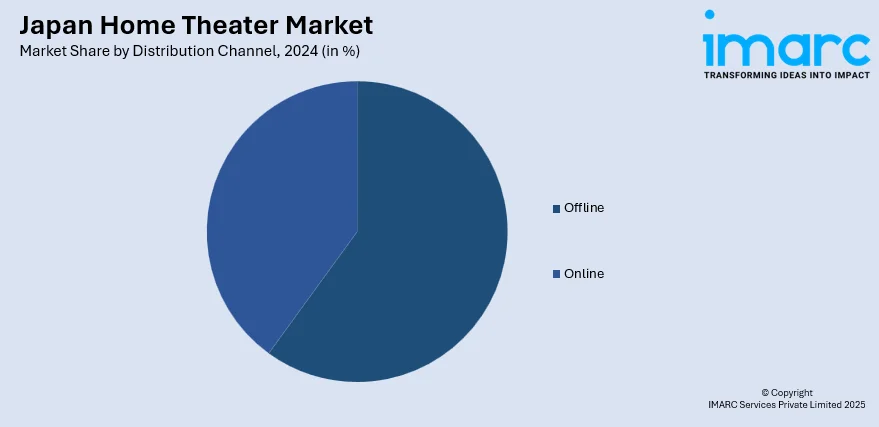
Japan Home Theater Market Size, Share, Trends and Forecast by Product, Distribution Channel, and Region, 2025-2033
Japan Home Theater Market Overview:
The Japan home theater market size reached USD 729.24 Million in 2024. Looking forward, IMARC Group expects the market to reach USD 1,679.45 Million by 2033, exhibiting a growth rate (CAGR) of 8.70% during 2025-2033. At present, the growing acceptance of smart home technology is offering a favorable market outlook. Moreover, the increasing demand for high-definition audio and video experiences is impelling the market growth. Apart from this, availability of content from streaming services is expanding the Japan home theater market share.
|
Report Attribute
|
Key Statistics
|
|---|---|
|
Base Year
|
2024 |
|
Forecast Years
|
2025-2033
|
|
Historical Years
|
2019-2024
|
| Market Size in 2024 | USD 729.24 Million |
| Market Forecast in 2033 | USD 1,679.45 Million |
| Market Growth Rate 2025-2033 | 8.70% |
Japan Home Theater Market Trends:
Growing Acceptance of Smart Home Technology:
The Japan home theater industry is driven by the growing acceptance of smart home technology. People are adopting more smart devices in their homes and want these devices to be interconnected seamlessly and provide enriched entertainment experiences. Home theaters are now made more compatible with other smart home devices like voice assistants, smart lighting, and home automation platforms. With the increased use of smart TVs, wireless speakers, and streaming audio systems, people are choosing home theater results that deliver high-quality sound and engaging experiences. This increased convergence of smart home capabilities with home theater systems is rising the level of convenience and usability in entertainment equipment, making it more appealing to technologically inclined individuals. With ongoing development in artificial intelligence (AI) and Internet of Things (IoT), smart home features are driving the demand for advanced home theater products in Japan. The IMARC Group predicts that the Japan home automation market size is expected to attain USD 16.19 Billion by 2033. This will further drive the need for smart home theaters in the country.

To get more information of this market, Request Sample
Growing Content Universe and Streaming Services
The availability of content from streaming services is also driving the demand for home theater systems in Japan. As people move towards on-demand video and audio content, there is a rise in the need for equipment that provides a cinematic experience. According to Omdia, in 2024, Netflix crossed the 10 million subscription milestone in Japan. Streaming platforms continuously augment their catalogs to feature 4K UHD and Dolby Atmos content, further promoting the adoption of high-end home theater solutions to fully appreciate such high-quality content. The accessibility of such content, combined with the presence of ultra-high-definition content, created the need for progressively advanced home theater systems that deliver premium quality image and sound. As the content environment is changing, with new technology and services coming on board, individuals are spending in home theater solutions that align with the transitions and improve their listening and viewing experience.
Increasing Demand for High-Definition Audio and Video:
The increasing demand for high-definition audio and video experiences is impelling the Japan home theater market growth. With people continuing to value high-quality home entertainment, they are spending money on sophisticated home theater systems delivering high-quality sound and images. The increase in the use of 4K and 8K television sets, and the global availability of high-resolution audio formats, is encouraging people to invest more in home theater systems to keep up with the better-quality content found in the market. Firms are constantly enhancing their product line with technology such as Dolby Atmos, 3D audio systems, and ultra-high-definition screens, which meet this growing demand for premium audio-visual experiences. With more people choosing enhanced viewing and listening experiences, the need for high-quality home theater systems is rising, further emphasizing the value of video and audio quality in the industry.
Japan Home Theater Market Segmentation:
IMARC Group provides an analysis of the key trends in each segment of the market, along with forecasts at country and regional levels for 2025-2033. Our report has categorized the market based on product and distribution channel.
Product Insights:
- Home Theatre in a Box System
- Sound Bar
- Component System
The report has provided a detailed breakup and analysis of the market based on the product. This includes Home Theatre in a box system, sound bar, and component system.
Distribution Channel Insights:

- Offline
- Online
A detailed breakup and analysis of the market based on the distribution channel have also been provided in the report. This includes offline and online.
Regional Insights:
- Kanto Region
- Kansai/Kinki Region
- Central/ Chubu Region
- Kyushu-Okinawa Region
- Tohoku Region
- Chugoku Region
- Hokkaido Region
- Shikoku Region
The report has also provided a comprehensive analysis of all the major regional markets, which include Kanto Region, Kansai/Kinki Region, Central/ Chubu Region, Kyushu-Okinawa Region, Tohoku Region, Chugoku Region, Hokkaido Region, and Shikoku Region.
Competitive Landscape:
The market research report has also provided a comprehensive analysis of the competitive landscape. Competitive analysis such as market structure, key player positioning, top winning strategies, competitive dashboard, and company evaluation quadrant has been covered in the report. Also, detailed profiles of all major companies have been provided.
Japan Home Theater Market Report Coverage:
| Report Features | Details |
|---|---|
| Base Year of the Analysis | 2024 |
| Historical Period | 2019-2024 |
| Forecast Period | 2025-2033 |
| Units | Million USD |
| Scope of the Report | Exploration of Historical Trends and Market Outlook, Industry Catalysts and Challenges, Segment-Wise Historical and Future Market Assessment:
|
| Products Covered | Home Theatre in A Box System, Sound Bar, Component System |
| Distribution Channels Covered | Offline, Online |
| Regions Covered | Kanto Region, Kansai/Kinki Region, Central/ Chubu Region, Kyushu-Okinawa Region, Tohoku Region, Chugoku Region, Hokkaido Region, Shikoku Region |
| Customization Scope | 10% Free Customization |
| Post-Sale Analyst Support | 10-12 Weeks |
| Delivery Format | PDF and Excel through Email (We can also provide the editable version of the report in PPT/Word format on special request) |
Key Questions Answered in This Report:
- How has the Japan home theater market performed so far and how will it perform in the coming years?
- What is the breakup of the Japan home theater market on the basis of product?
- What is the breakup of the Japan home theater market on the basis of distribution channel?
- What is the breakup of the Japan home theater market on the basis of region?
- What are the various stages in the value chain of the Japan home theater market?
- What are the key driving factors and challenges in the Japan home theater market?
- What is the structure of the Japan home theater market and who are the key players?
- What is the degree of competition in the Japan home theater market?
Key Benefits for Stakeholders:
- IMARC’s industry report offers a comprehensive quantitative analysis of various market segments, historical and current market trends, market forecasts, and dynamics of the Japan home theater market from 2019-2033.
- The research report provides the latest information on the market drivers, challenges, and opportunities in the Japan home theater market.
- Porter's five forces analysis assist stakeholders in assessing the impact of new entrants, competitive rivalry, supplier power, buyer power, and the threat of substitution. It helps stakeholders to analyze the level of competition within the Japan home theater industry and its attractiveness.
- Competitive landscape allows stakeholders to understand their competitive environment and provides an insight into the current positions of key players in the market.
Need more help?
- Speak to our experienced analysts for insights on the current market scenarios.
- Include additional segments and countries to customize the report as per your requirement.
- Gain an unparalleled competitive advantage in your domain by understanding how to utilize the report and positively impacting your operations and revenue.
- For further assistance, please connect with our analysts.
 Request Customization
Request Customization
 Speak to an Analyst
Speak to an Analyst
 Request Brochure
Request Brochure
 Inquire Before Buying
Inquire Before Buying




.webp)




.webp)












